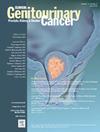Real-World Survival Outcomes of Partial Versus Radical Nephrectomy: Cause-Specific and Time-Dependent Effects
IF 2.7
3区 医学
Q3 ONCOLOGY
引用次数: 0
Abstract
Objectives
To assess the prognosis of radical nephrectomy (RN) and partial nephrectomy (PN) in patients with localized renal cell carcinoma (RCC), with particular consideration of cause-specific mortality and time-dependent effects on real-world survival outcomes.
Patients and Methods
This multicenter, retrospective study included patients with localized RCC who underwent RN or PN; 1:1 propensity score matching was conducted to minimize selection bias in the nonrandom assignment of patients to the PN and RN groups. Overall survival (OS), cancer-specific mortality (CSM), and other-cause mortality (OCM) were evaluated in patients who underwent RN or PN using conditional survival (CS) analysis.
Results
In total, 802 patients were included in the RN and PN groups (401 patients in each). The RN group had a significantly poorer OS than the PN group (P = .031). CS analysis indicated that neither the RN nor the PN groups had significantly enhanced survival rates over extended survival periods. The CS rate was consistently higher in the PN group than in the RN group at all time points during follow-up. Only the conditional cumulative incidence of OCM in the RN group was consistently high during the follow-up period, but that of OCM in the PN group and CSM in these groups remained low, irrespective of the length of survival.
Conclusion
PN was associated with better OS than RN in patients with localized RCC. CS analysis revealed this was attributed to a consistently high rate of OCM in the RN group during the follow-up period.
部分肾切除术与根治性肾切除术的实际生存结果:原因特异性和时间依赖性影响。
目的:评估局部肾细胞癌(RCC)患者根治性肾切除术(RN)和部分肾切除术(PN)的预后,特别考虑病因特异性死亡率和对实际生存结果的时间依赖性影响。患者和方法:这项多中心回顾性研究纳入了接受RN或PN治疗的局限性RCC患者;进行1:1倾向评分匹配,以尽量减少非随机分配到PN组和RN组的患者的选择偏差。使用条件生存(CS)分析评估接受RN或PN患者的总生存期(OS)、癌症特异性死亡率(CSM)和其他原因死亡率(OCM)。结果:共纳入RN组和PN组802例(各401例)。RN组的OS明显低于PN组(P = 0.031)。CS分析表明,在延长的生存期内,RN组和PN组的存活率都没有显著提高。在随访期间的所有时间点,PN组的CS率始终高于RN组。在随访期间,只有RN组的OCM条件累积发生率始终较高,但无论生存时间长短,PN组和CSM组的OCM条件累积发生率均保持较低。结论:在局限性肾细胞癌患者中,PN比RN有更好的OS。CS分析显示,这是由于在随访期间,RN组的OCM发生率一直很高。
本文章由计算机程序翻译,如有差异,请以英文原文为准。
求助全文
约1分钟内获得全文
求助全文
来源期刊

Clinical genitourinary cancer
医学-泌尿学与肾脏学
CiteScore
5.20
自引率
6.20%
发文量
201
审稿时长
54 days
期刊介绍:
Clinical Genitourinary Cancer is a peer-reviewed journal that publishes original articles describing various aspects of clinical and translational research in genitourinary cancers. Clinical Genitourinary Cancer is devoted to articles on detection, diagnosis, prevention, and treatment of genitourinary cancers. The main emphasis is on recent scientific developments in all areas related to genitourinary malignancies. Specific areas of interest include clinical research and mechanistic approaches; drug sensitivity and resistance; gene and antisense therapy; pathology, markers, and prognostic indicators; chemoprevention strategies; multimodality therapy; and integration of various approaches.
 求助内容:
求助内容: 应助结果提醒方式:
应助结果提醒方式:


